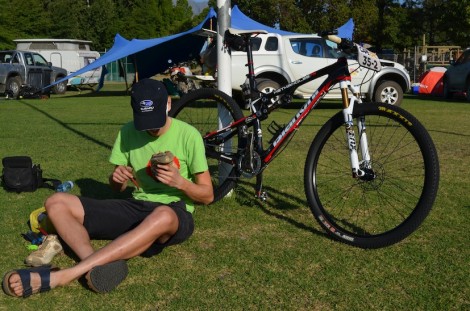Keeping your bike in one piece can be half the challenge in a demanding stage race. Depending on the mountain bike stage race you are in, you may be faced with mud, dust, sand, or all of the above. Add a lot of climbing and you will also add a lot of descending – increasing the wear on both your drivetrain, brakes and tyres. One of the most important things to do between stages is rest and recuperate. The faster you can start the recovery, the better you will feel the next day. But you must also factor in bike maintenance. You can be completely on top of your recovery, but if a small maintenance issue becomes a big one with neglect, your race could be over. If it’s a pairs race, it can end your race partners race as well.
Some races have great mechanical support, and if you are unsure of what is causing a problem, see one of the professional mechanics. But these pointers should keep your bike running. At the Cape Epic your bike will be jet washed. yet this is done by the experienced Pragma crew, and it saves you a lot of time and energy. At other stage races it’s worthwhile doing a full clean down if a jet wash is available. You will be able to get the bulk of the muck off your bike, and you’re about to re-lubricate it anyway.
Here’s a brief rundown of what Will Hayter does to his Subaru-MarathonMTB.com Team Bianchi in the evenings. After a massage, yet before dinner.
Check all bearings are smooth, and free of play
This includes your headset, bottom bracket, pedals and front and rear hubs. Check for play against the way that they move. In this case, we are looking for lateral play in the bottom bracket by trying to move the crank arm towards the bike. A loose bearing will quickly destroy itself, and needs to be attended to.
Inspect your drivetrain
You’re looking for wear and damage. Check chainring teeth, chain links, jockey wheels and your cassette. Ensure your hanger is straight, and that your gear cables and outer aren’t damaged in anyway. Once you’re done, check your shifting is as it should be, and make adjustments as required.
Lube your chain
Make sure you choose the right chain lube. Will has been using Juice Lubes Ceramic Lube with some success, but does use the Motorex lube stations in the race. It can be worthwhile using a spray based teflon lube lightly on the moving parts of your derailleurs too.
Check all bolts and pivots
Don’t just try to over tighten everything – know what you’re doing and how tight each bolt should be.
Anything can rattle loose without you realising right away. Get used to checking all bolts – you’re not aiming to over tighten them, but just ensure they are still tight. It is not unheard of for rotor bolts to rattle out, or bottle cage bolts, in rough terrain. Particular attention should be paid to pivot bolts. Use a quality tool, and know how tight they should be.
Check for brake wear and adjustment
Brakes take a lot of abuse, yet they are essential! So it’s easy to forget about them until they’re not working. Check for pad wear, calliper alignment, and rotor trueness. You should have compatible spare brake pads as part of your spares kit with you at the race. Make sure you are familiar with your brakes, and know how to replace pads.
Wipe down suspension seals
Have you ever read the service manual for your fork or shock? If you’re competing in a stage race like the Cape Epic, Transalp, or a similar length race you will probably go over the recommended service period in your racing hours alone. Use a clean rag to wipe down excess grime from around the seals. If you’re confident, you can pop the seals on the fork legs to clean.
Check suspension pressure
Air seeps out of shocks just like tyres. Not really at the same rate, but it’s worth checking your fork and shock pressure every few days. KNow what your regular settings are, or what you run for the terrain that you’re in. It’s also worth checking the rebound and compression damping settings too.
Wheels: true, treaded and pressurised
Don’t ignore your wheels – check your tyres daily for sidewall abrasions, cuts, and thorns. Replace them if you’re not sure. Spin the wheels to check if they are true. It is worth investing in a digital pressure gauge, or use a track pump to ensure your tyres are at the desired pressure.
Inspect your shoes and cleats
This is an easy one to forget. But these aren’t free of abuse! Your cleat bolts can loosen, as can BOA lace spool cover. They can also need cleaning out in mucky conditions. Take your inner soles out and free yourself from the build up of dirt too.
Test ride
Make sure your handy work works. That’s the crucial part. Once you’re done, secure your bike in the bike park, or lock it somewhere safe. You need it tomorrow, so don’t leave it to chance.

